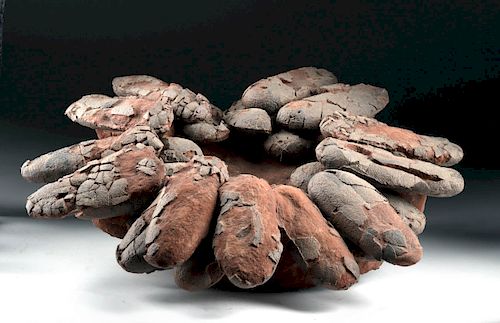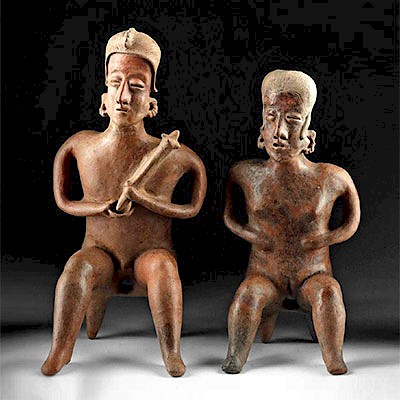Extremely Rare Theropod Dinosaur Egg Nest - 25 Eggs!
Lot 174
About Seller
Artemis Fine Arts
686 S Taylor Ave, Ste 106
Louisville, CO 80027
United States
Selling antiquities, ancient and ethnographic art online since 1993, Artemis Gallery specializes in Classical Antiquities (Egyptian, Greek, Roman, Near Eastern), Asian, Pre-Columbian, African / Tribal / Oceanographic art. Our extensive inventory includes pottery, stone, metal, wood, glass and textil...Read more
Estimate:
$40,000 - $60,000
Absentee vs Live bid
Two ways to bid:
- Leave a max absentee bid and the platform will bid on your behalf up to your maximum bid during the live auction.
- Bid live during the auction and your bids will be submitted real-time to the auctioneer.
Bid Increments
| Price | Bid Increment |
|---|---|
| $0 | $25 |
| $300 | $50 |
| $1,000 | $100 |
| $2,000 | $250 |
| $5,000 | $500 |
| $10,000 | $1,000 |
| $20,000 | $2,500 |
| $50,000 | $5,000 |
| $100,000 | $10,000 |
| $200,000 | $20,000 |
About Auction
By Artemis Fine Arts
May 23, 2019
Set Reminder
2019-05-23 10:00:00
2019-05-23 10:00:00
America/New_York
Bidsquare
Bidsquare : Exceptional Day 2 Ethnographic Tribal Fossils
https://www.bidsquare.com/auctions/artemis-gallery/exceptional-day-2-ethnographic-tribal-fossils-4136
Day 2 of an important 2-day auction featuring exceptional ethnographic art from around the world. Today's sale will feature Pre-Columbian from the ancient americas, Native American, African / Tribal, Oceanic, Spanish Colonial, and incredible Fossils. Artemis Fine Arts info@artemisfinearts.com
Day 2 of an important 2-day auction featuring exceptional ethnographic art from around the world. Today's sale will feature Pre-Columbian from the ancient americas, Native American, African / Tribal, Oceanic, Spanish Colonial, and incredible Fossils. Artemis Fine Arts info@artemisfinearts.com
- Lot Description
East Asia, China, Liaoning, later Cretaceous Period, ca. 100 to 66 million years ago. 25 theropod dinosaur eggs preserved in a distinctive circular clutch, resting atop their original matrix, with most of their edges exposed and cleaned. The interiors have fossilized to a hard, dark red sandstone, while the eggshells, also fossilized, are black, with the texture of the shell nicely preserved in many areas. Note that the eggs appear in "pairs" - this tells us something important about female dinosaurs. Modern birds, the descendants of theropods, have evolved to only have one ovary - believed to assist them in being light enough to fly - but female dinosaurs laid their eggs in pairs, indicating that they still had both ovaries. The layered tiers of eggs are also fascinating, giving us an idea of how many eggs these animals could lay in a breeding season. A similar clutch of eggs has been found in China with the remains of an Oviraptor parent still sitting over them! Size: 22.9" W x 6.5" H (58.2 cm x 16.5 cm)
Dinosaur eggs remain a rare and treasured find - they were first discovered in France in 1859, but were believed to be from a giant bird. The first recognized find was from Mongolia in 1923. The preservation of eggshell is incredible when you consider that they are less than the thickness of a human hair! What might these eggs have looked like in life? They were probably colorful and speckled. Recent discoveries of fossil eggshells from China indicate that eggs were blue-green, with spots, in order to keep them camouflaged.
It is almost impossible to discern what species eggs are from, but it is possible to classify the general type - elongated ovoid forms are from theropods. These are the bipedal carnivorous dinosaurs, including T. Rex and the various forms of including Velociraptor and Oviraptor. Theropods are the dinosaurs from which modern birds evolved! Note how these eggs are in an open nest formation, much like most birds today - this was actually rare among dinosaurs, who generally buried their eggs in dirt and vegetation, like crocodiles. Scientists believe that some species of smaller theropods - the maniraptorans - evolved to have open nests and brooding behavior, meaning that they carefully watched over their nests before and after their young hatched. This is thought to be an important step towards the evolution of birds putting their nests into trees.
Provenance: private Smith collection, San Diego, California, USA, purchased in the 1990s
All items legal to buy/sell under U.S. Statute covering cultural patrimony Code 2600, CHAPTER 14, and are guaranteed to be as described or your money back.
A Certificate of Authenticity will accompany all winning bids.
We ship worldwide and handle all shipping in-house for your convenience.
#145869Preservation of eggshell is partial as shown. Left in original matrix with edges cleared away. Overall very nice preservation for its age!Condition
- Shipping Info
-
All shipping is handled in-house for your convenience. Your invoice from Artemis Gallery will include shipping calculation instructions. If in doubt, please inquire BEFORE bidding for estimated shipping costs for individual items.
-
- Buyer's Premium



 EUR
EUR CAD
CAD AUD
AUD GBP
GBP MXN
MXN HKD
HKD CNY
CNY MYR
MYR SEK
SEK SGD
SGD CHF
CHF THB
THB















